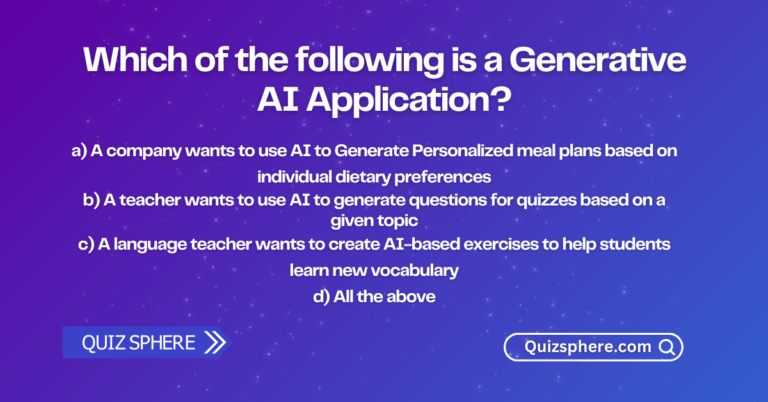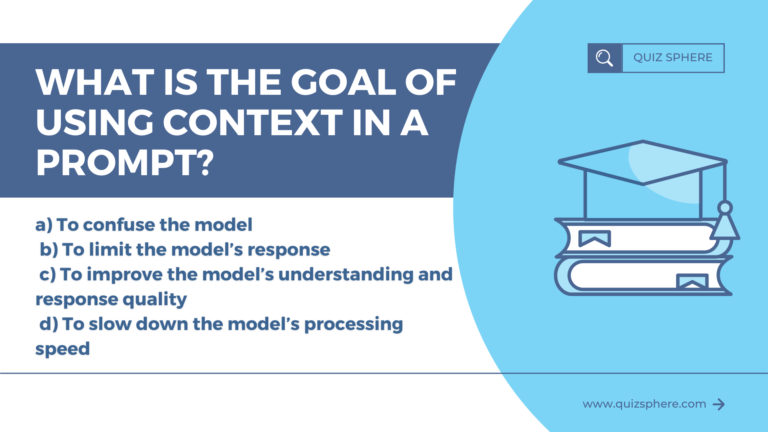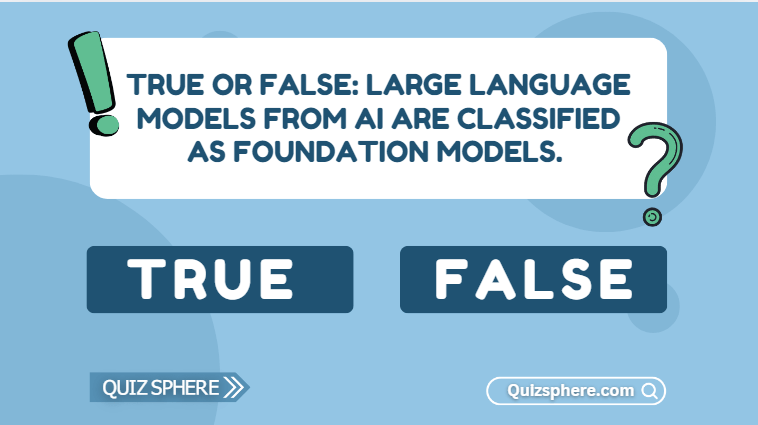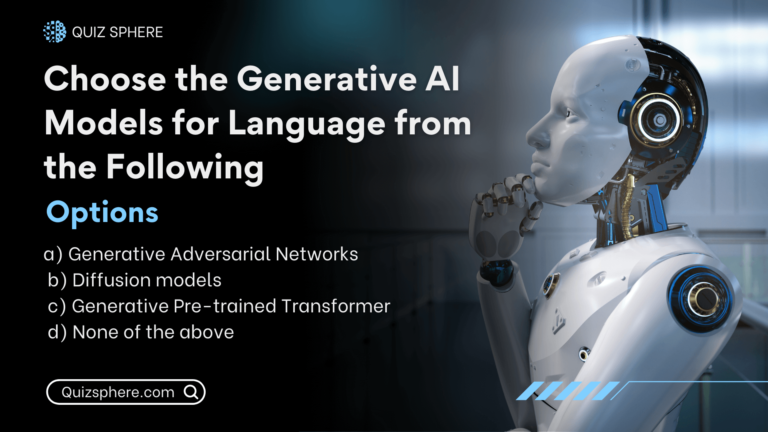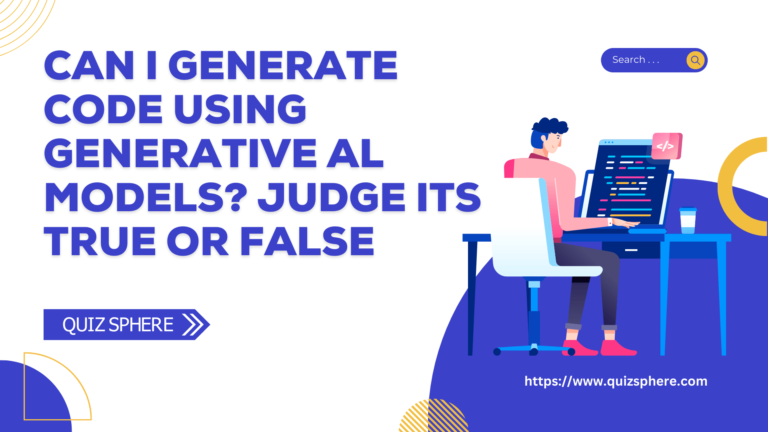Which of the following is a Generative AI Application?
With the high emergence of problems and tasks that need solutions, Generative AI makes it easier to solve problems and interact with technology. The question, “Which of the following is a Generative AI application?” makes one think deeply because it emphasizes the wide range of possibilities that this technology can solve.
Quiz Sphere Homework Help: Questions and Answers: Which of the following is a Generative AI Application?
Options:

a) A company wants to use AI to Generate Personalized meal plans based on individual dietary preferences
b) A teacher wants to use AI to generate questions for quizzes based on a given topic
c) A language teacher wants to create AI-based exercises to help students learn new vocabulary
d) All the above
The answer is clear:
d) All the above.
All the choices provided showcase the capacity of AI Generative fields, hence providing answers assuming understanding as well as many other algorithms. This will be in the forms of content, or plan generating abilities that we can clearly see demonstrates that every answer is a valid one. In this article, the readers will understand the reasons behind noticing that the answer to this question of AI is ‘All the above’ and several other multiple-choice answers.
What is Generative AI?
It is necessary to explain what generative AI is before moving toward particular uses of it. Generative AI is defined as a subdivision of artificial intelligence systems tasked with the creation of new content or solutions by learning certain data patterns. Unlike the been performing a mere data processing and analysis, generative AI applications go further into producing or generating texts, images, audios, videos and other solutions based on the specified text inputs.
Moving on to the next idea, it is time to examine why each option is correct.
a) A company wants to use AI to Generate Personalized Meal Plans Based on Individual Dietary Preferences.
Why is this Generative AI?
By using data, such as someone’s preferences, health objectives and dietary restrictions, Generative AI can easily devise ideal meal plans.
With the help of algorithm trained on serving people’s preferences through nutritional science and numerous recipe databases, AI combines diverse meals to give a uniquely tailored outcome based on user requirements.
How It Works:
- Users provide dietary information which consists of calorie intake, allergies, and preferred cuisine.
- The AI utilizes this input along with pre-existing nutritional databases.
- A detailed meal plan is created which has aligned portion sizes of every recipe so that user’s preferences and nutritional goals are always met.
Applications in Real Life:
- Health Apps: MyFitnessPal and Noom are some examples where generative AI has taken the forefront in proposing meals.
- Fitness Programs: Specification meal plans for sportsmen or patients in obesity reduction programs.
- Healthcare: Dietary routine for chronic illnesses patients like diabetes or cardiac diseases.
Why It Matters:
Users can save time and ensures nutritional accuracy which can help them foster healthy eating habits. With tailored approaches provided through AI, it becomes extremely easy to address individual concerns which would take human hours to work out.
b) A Teacher Wants to Use AI to Generate Questions for Quizzes Based on a Given Topic
What Makes This Generative AI?
This is classified as generative AI as it can suggest questions based on a topic or complexity by comprehensively studying the resources it was trained on.
It is capable of creating contextually relevant new questions, which makes it a vital asset to teachers.
How it Works:
- Input Data: The instructor inputs a subject or a particular section of the syllabus.
- Data Analysis: The AI analyzes the input and cross-references it with its training data – textbooks or previous questions.
- Output Generation: Based on the requirements, the system designs different types of quiz questions: multiple-choice, fill-in-the-blank or open-ended.
Applications in Real Life:
- EdTech Platforms: Other tools like Quizlet or Khan Academy implement generative AI by devising revision quizzes for learners.
- Classroom Use: Teachers can easily prepare different quizzes for students of varying abilities with varying difficulty levels.
- Corporate Training: The business uses AI technology to generate assessments relevant to the employee training modules.
Why it matters:
These generative AI techniques reduce the workload for educators drastically by speeding up the quiz creation process. Furthermore, it makes sure the questions are curriculum-compliant and increases the variety of questions to aid learning.
c) A language teacher wants to generate vocabulary exercises in AI to assist students in the learning process.
Why is this Generative AI?
Generative AI is able to create exercises, games and tasks ad hoc depending on the level of the learner. These automated exercises are done in real time, which in turn makes engaging in vocabulary learning much more productive and fun.
Process:
- Data Input: The teacher inputs the target vocabulary, details regarding the student’s proficiency level and the learning objectives.
- Data Processing: The AI scans the input and looks up linguistic databases or corpora.
- Data Output: AI creates exercises such as sentence completion, flashcard sets, word puzzles or context-based vocabulary games.
Real Life Case Studies:
- Language Learning Apps: Exercises and language practice tasks for student users in Duolingo and Babbel are based on material created with the help with generative AI.
- Classroom Aids: Teachers can prepare customized assignments for students that have problems with certain words.
- Support Lesson: Vocabulary exercises in the context of different exams such as TOEFL, IELTS, or SAT can be built using Generative AI.
Importance:
It allows students using this type of Generative AI to learn in a very specific manner. This focuses mostly on helping people that do not speak certain languages learn them with ease.
Why “d) All the above” is the Correct Answer:
These four choices are best explained with the same reason: the Generative AI capabilities stem from all their essences in unison – the creation of solutions based on data is valuable. Let’s examine why “d) All the above” is correct.
- Diversity of Applications:
These examples cut across several industry verticals: language, education, healthcare, and even industrial marketing. This is proof how effortless allowing substantial user and industry scope through generative AI Adapts to the industry needs adroitly without losing focus on industry specifics.
- Adaptation and Personalization:
The most basic benefit of AI Generative is any platform can adapt to the personal specification of a person. This could be generating exercises, quizzes, meal plans, and so on.
- Time and Effort Saving:
Automation of monotonous tasks that could have been done manually is a system solution for scaling up, allowing fast and precise provision of solutions, and supporting rapid growth.
- Improved User Interface:
All users of any application are given these best features to expect within the processes of the application—seamless and captivating interfaces that are effective rather than mundane.
Moreover, the productivity and results obtained by users and learners increased within the context of generative AI because they were able to disengage from traditional learning methods of education.
Closing Remarks
Generative AI is a type of technology that is revolutionizing the businesses of the modern world due to its ability to provide truly innovative and creative-focused solutions. The case examples provided for this question broadly illustrate some of the reasons why this claim could be made.
- These technologies assist healthcare practitioners by developing easy and healthy meals.
- These technologies also save teachers time by assisting in preparing quizzes and even drafting questions for the lessons.
- Personalization of interactivity and gamification helps increase the participation and engagement of learners when acquiring new vocabulary.
This is why deciding to choose the answer “d) All the above” provides a clear and strong understanding of generative AI.
The very nature of a civilization is that technology will continue advancing, and as a result, the range for its application broadens, further integrating into the life and work activities of people.
As much as these facets are gaining such importance and are more accessible to all people, it becomes simpler to use generative AI.
No matter your profession, be it educator, fitness enthusiast, or software developer, everything now intersects with generative AI. The lozenge-shaped reflective surfaces hover above, which we owe it to ourselves to alter and wield towards a future that is far smarter and more effective.


